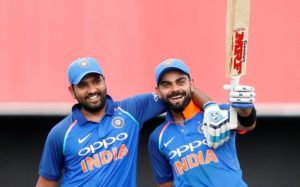Kohli and Sharma smash Sri Lanka to smithereens

By Kersi Meher-Homji
India defeated Sri Lanka in all three formats of cricket this November-December in India; 1-0 in Tests with 2 matches drawn, 2-1 in One-Day Internationals (ODIs) and 3-0 in Twenty20 Internationals (T20I).
Thus out of nine matches India won six, Sri Lanka one with two drawn heavily in India’s favour.
Although Indian bowlers contributed handsomely, it was India’s batting ”“ especially by their captains; Virat Kohli in the Tests and Rohit Sharma in ODIs and T20Is when Kohli took a break to get married to the beautiful Indian actress Anushka Sharma.
Kohli was at his scintillating best in the three Tests, hitting centuries in every Test; 104 not out in the first Test in Kolkata, 213 in the second Test in Nagpur and 243 in the third and final Test in foggy, misty Delhi.
Thus in three Tests he amassed 610 runs at an average of 152.50 with two double centuries, a century and a fifty, hitting four sixes. He became the sixth batsman to register two double centuries in consecutive Test innings. The others are England’s Wally Hammond twice in 1928 and in 1933, Bradman in 1934, India’s Vinod Kambli in 1993, Sri Lanka’s Kumar Sangakkara in 2007 and Australia’s Michael Clarke in 2012.
Kohli has also scored most double centuries as a captain, six in 32 Tests. West Indian great Brian Lara previously held the record; five double centuries in 47 Tests as captain. Don Bradman had hit four double centuries in 24 Tests when he captained Australia.
But when Kohli, age 29, took a break to get married, opening batsman Rohit Sharma took over as India’s captain and master blaster. Under him India won the ODIs 2-1 and T20s 3-0.
In three ODIs, Sharma smashed 217 runs at 108.50 with one double century. And in three T20s, he scored 162 runs at 54.00 with one century.
In the second ODI against Sri Lanka at Mohali this month, he hit an unbeaten 208 with 13 fours and 12 sixes. He became the only player to record three ODI double tons; following his 209 (12 fours, 16 sixes) against Australia at Bangaluru in 2013 and 264 (33 fours and 9 sixes) against Sri Lanka at Kolkata in 2014.
Sharma’s 264 (in 2014) remains the highest score in the history of ODIs. The next best is 237 not out by New Zealander Martin Guptill against West Indies in Wellington in 2015.
In the second T20I at Indore, he hit 118 runs with 12 fours and 10 sixes. He reached his century in 35 balls, joint fastest in the history of T20Is. South Africa’s David Miller had also reached his century off 35 balls against Bangladesh this October.
But Sharma is not just a limited-overs specialist. Selected in two Tests against Sri Lanka in the current series he scored 217 runs at a fantastic average of 217.00 (highest score 102 not out).
In the three formats in this series, he scored 596 runs at 99.33 with three centuries (highest score 208 not out) and two fifties. And he belted 27 sixes; three in Tests, 13 in ODIs and 11 in T20 Internationals.
Having defeated Sri Lanka home and away, India under the captaincy of Virat Kohli gets ready to tour South Africa for a series of three Tests (the first Test starting at Cape Town on 5 January 2018), six ODIs and three T20 Internationals.
Short URL: https://indiandownunder.com.au/?p=10282
